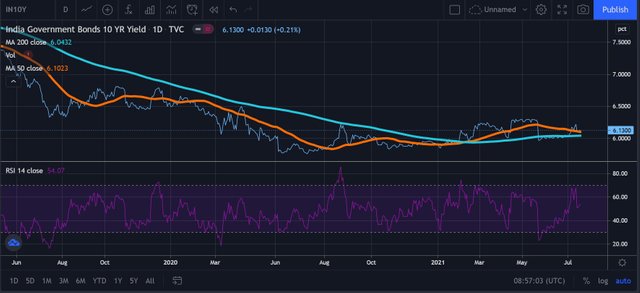Lower rates for now, says India's central bank governor
The governor of India's central bank, Reserve Bank of India, Mr. Shaktikanta Das, gave an interview to a leading financial newspaper last week. During the interview, he was asked very similar questions as are asked to central bankers around the globe. The topics ranged from money printing, to yield curve control and his responses were pleasingly very different from those of his global peers. Let me highlight some of the key insights from his interview as they give some sense about the shape of monetary policy in India in the near future.
When asked about directly funding government spending, i.e. money printing, the head of RBI said that such activities are of no use and pose serious downsides. He mentioned that the bank's focus is to manage the pace of money flow and not create money out of thin air.
The government bond market in India has recently witnessed that investors are not willing to lend money for 10 years to the government at 6%. The 10-year yield in India has been hovering around that level for some time now.

In fact, the RBI itself has been responsible for setting the cut-off for 10-year government bond auctions at 6%. In the most recent one, RBI raised the cut-off to 6.1%. When asked about RBI's role in fixing the interest rate and ensuring cheaper borrowing for the government than the market would allow, the governor said that the central bank is not fixated on any number. All the bank wants to ensure is an orderly steepening of the yield curve. He also mentioned that funding government expenses by printing money is not allowed by law in India and by keeping rates low, the central bank is seeing increased economic activity. He used the example of mortgage rates that are at all-time lows in India. As a result, the construction sector has seen a pick-up in activity, and demand for housing loans has grown.
He also talked about the inflation consequence of low rates and mentioned that the bank seeing inflation as transitory. As is being said by many, inflation at the moment is due to supply-side disruptions and Das reiterated that. He used this argument to indicate that rates will continue to stay low in the near future. He did ask the central and state governments to reduce certain taxed to curb inflation.
Now, in theory, Das made some very sound remarks about money printing and keeping yields low. However, it is evident that there are legal barriers because of which money printing is not an option. Who knows, without laws preventing that, India would also have seen money printer going brrr. We also know that if needed, new laws can be passed to make it easier for the government to arrange money. I agree with keeping rates low for now. The economy isn't heating up that the bank needs to raise rates. The government, both at the central and the state level, should indeed do more than just blaming others for inflation.
Greetings @karamyog the issue of money printing by central banks led by governments of countries is a never ending issue, this phenomenon has been one of the causes of the emergence of Bitcoin to alleviate the harsh situation of banking and money without foundation. Thanks for the contribution
true, bitcoin was designed to bring real internet based money and store of value. inflation is created by central banks and then they keep pretending to fight it.